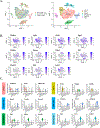Single cell approaches to address adipose tissue stromal cell heterogeneity
- PMID: 32026949
- PMCID: PMC7875330
- DOI: 10.1042/BCJ20190467
Single cell approaches to address adipose tissue stromal cell heterogeneity
Abstract
A central function of adipose tissue is in the management of systemic energy homeostasis that is achieved through the co-ordinated regulation of energy storage and mobilization, adipokine release, and immune functions. With the dramatic increase in the prevalence of obesity and obesity-related metabolic disease over the past 30 years, there has been extensive interest in targeting adipose tissue for therapeutic benefit. However, in order for this goal to be achieved it is essential to establish a comprehensive atlas of adipose tissue cellular composition and define mechanisms of intercellular communication that mediate pathologic and therapeutic responses. While traditional methods, such as fluorescence-activated cell sorting (FACS) and genetic lineage tracing, have greatly advanced the field, these approaches are inherently limited by the choice of markers and the ability to comprehensively identify and characterize dynamic interactions among stromal cells within the tissue microenvironment. Single cell RNA sequencing (scRNAseq) has emerged as a powerful tool for deconvolving cellular heterogeneity and holds promise for understanding the development and plasticity of adipose tissue under normal and pathological conditions. scRNAseq has recently been used to characterize adipose stem cell (ASC) populations and has provided new insights into subpopulations of macrophages that arise during anabolic and catabolic remodeling in white adipose tissue. The current review summarizes recent findings that use this technology to explore adipose tissue heterogeneity and plasticity.
Keywords: plasticity; single cell RNA-seq; stromal cells; white adipose tissue.
© 2020 The Author(s). Published by Portland Press Limited on behalf of the Biochemical Society.
Conflict of interest statement
Competing Interests
The authors declare that there are no competing interests.
Figures




References
-
- Sung H, Siegel RL, Rosenberg PS, Jemal A. Emerging cancer trends among young adults in the USA: analysis of a population-based cancer registry. Lancet Public Health. 2019;4(3):e137–e47. - PubMed
-
- Stolarczyk E Adipose tissue inflammation in obesity: a metabolic or immune response? Curr Opin Pharmacol. 2017;37:35–40. - PubMed
Publication types
MeSH terms
Grants and funding
LinkOut - more resources
Full Text Sources
Miscellaneous

